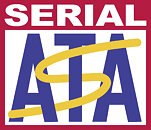- Joined
- Oct 9, 2007
- Messages
- 47,448 (7.50/day)
- Location
- Hyderabad, India
| System Name | RBMK-1000 |
|---|---|
| Processor | AMD Ryzen 7 5700G |
| Motherboard | ASUS ROG Strix B450-E Gaming |
| Cooling | DeepCool Gammax L240 V2 |
| Memory | 2x 8GB G.Skill Sniper X |
| Video Card(s) | Palit GeForce RTX 2080 SUPER GameRock |
| Storage | Western Digital Black NVMe 512GB |
| Display(s) | BenQ 1440p 60 Hz 27-inch |
| Case | Corsair Carbide 100R |
| Audio Device(s) | ASUS SupremeFX S1220A |
| Power Supply | Cooler Master MWE Gold 650W |
| Mouse | ASUS ROG Strix Impact |
| Keyboard | Gamdias Hermes E2 |
| Software | Windows 11 Pro |
The Serial ATA International Organization (SATA-IO), the storage industry consortium dedicated to sustaining the quality, integrity and dissemination of the Serial ATA (SATA ) technology, today announced the publication of the SATA Revision 3.5 Specification. Specification 3.5 introduces features that enable increased performance benefits and promote greater integration of SATA devices and products with other industry I/O standards.
"SATA-IO has a long tradition of participating in the industry and supporting new innovative technology. These new features underscore the versatility of the SATA standard," said Jim Hatfield, SATA-IO president. "SATA remains one of the most stable, yet adaptable, interfaces in the industry. We are pleased to be able to enhance SATA's compatibility benefits for our members and the industry by adding features which allow SATA and other I/O standards to coexist in a variety of environments."

As storage technologies continue to advance, the industry continues to demand improvements in performance, reliability and compatibility. To ensure that members and the industry continue to have a reliable storage solution, the SATA-IO has added new features to the ubiquitous specification that offer improvements in a number of areas including:
The specification is available to SATA-IO members for free, while non-members can purchase the specification by visiting this page.
View at TechPowerUp Main Site
"SATA-IO has a long tradition of participating in the industry and supporting new innovative technology. These new features underscore the versatility of the SATA standard," said Jim Hatfield, SATA-IO president. "SATA remains one of the most stable, yet adaptable, interfaces in the industry. We are pleased to be able to enhance SATA's compatibility benefits for our members and the industry by adding features which allow SATA and other I/O standards to coexist in a variety of environments."

As storage technologies continue to advance, the industry continues to demand improvements in performance, reliability and compatibility. To ensure that members and the industry continue to have a reliable storage solution, the SATA-IO has added new features to the ubiquitous specification that offer improvements in a number of areas including:
- Device Transmit Emphasis for Gen 3 PHY: aligns SATA with other characteristics of other I/O measurement solutions to help SATA-IO members with testing and integration.
- Defined Ordered NCQ Commands: allows the host to specify the processing relationships among queued commands and sets the order in which commands are processed in the queue.
- Command Duration Limit Features: reduces latency by allowing the host to define quality of service categories, giving the host more granularity in controlling command properties. The feature helps align SATA with the "Fast Fail" requirements established by the Open Compute Project (OCP) and specified in the INCITS T13 Technical Committee standard.
The specification is available to SATA-IO members for free, while non-members can purchase the specification by visiting this page.
View at TechPowerUp Main Site



